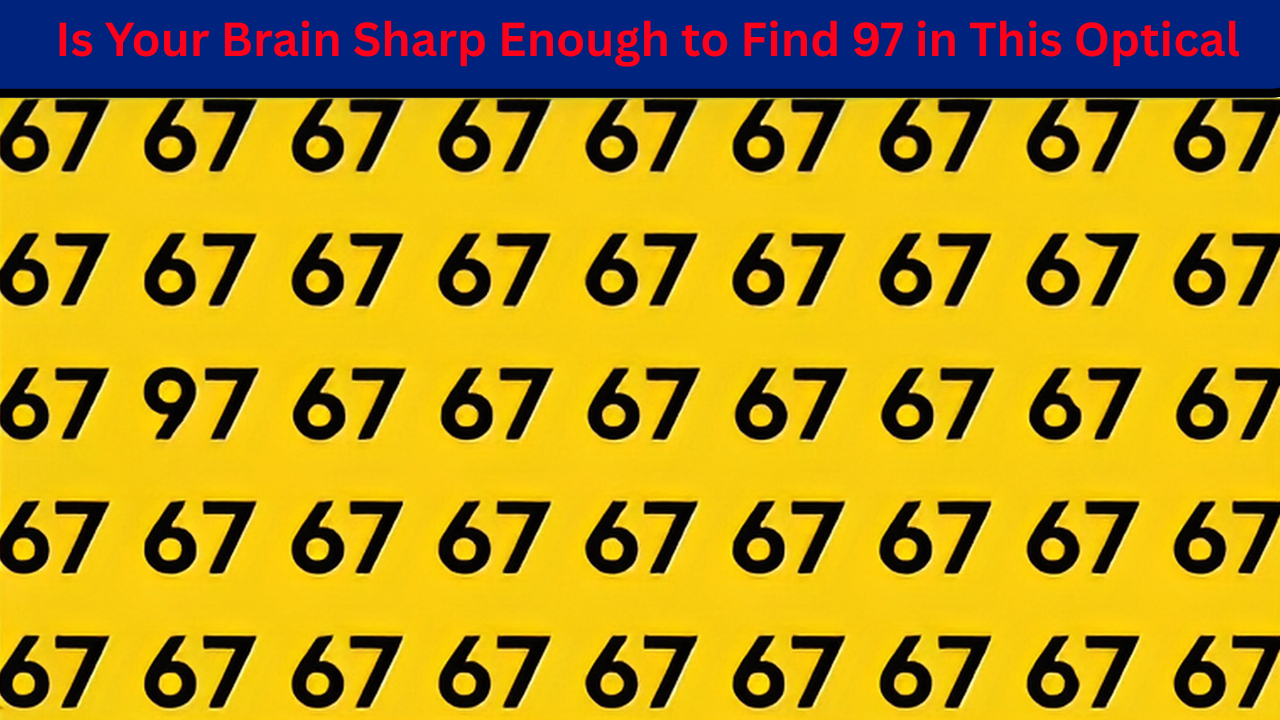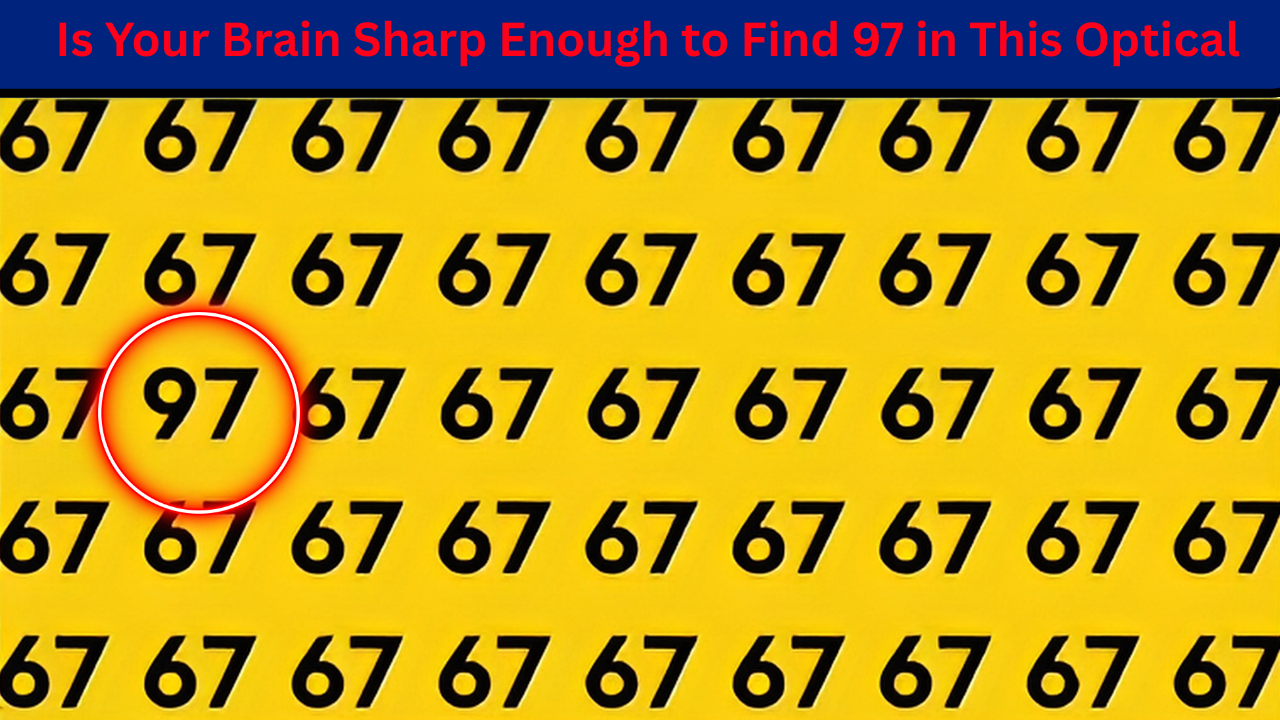Optical illusions have fascinated humanity for centuries, challenging our perception and teasing our brains with visual puzzles that seem to defy logic. Among these captivating brain teasers is a particularly intriguing one: an optical illusion that hides the number 97 within a complex pattern. This illusion has sparked curiosity across the internet, leaving many wondering, “Is my brain sharp enough to find 97?” In this 1500-word article, we’ll explore the science behind optical illusions, why finding 97 is so challenging, and how you can train your brain to master such visual puzzles.

What Are Optical Illusions?
Optical illusions are images or patterns that deceive our eyes and brain, causing us to perceive something that isn’t entirely accurate. They exploit the way our visual system processes information, often creating confusion between what we see and what is actually present. Illusions can involve distortions of size, shape, color, or perspective, and they reveal fascinating insights into how our brains interpret the world.
The optical illusion featuring the number 97 is a classic example of a hidden figure illusion. In this type, a specific shape or number is camouflaged within a larger, more chaotic pattern. The challenge lies in spotting the hidden element—97 in this case—amidst the visual noise. These illusions are not just fun; they test cognitive skills like attention to detail, pattern recognition, and visual processing speed.
Why Is Finding 97 So Hard?
The difficulty in spotting 97 stems from how our brains process complex visual information. When you first glance at the illusion, your eyes are bombarded with a mix of shapes, colors, and patterns designed to distract you. The number 97 is cleverly disguised, blending seamlessly with its surroundings. Here’s why this task is trickier than it seems:
-
Figure-Ground Organization: Our brains naturally separate images into a “figure” (the object of focus) and a “ground” (the background). In this illusion, the number 97 is part of the ground, making it hard to isolate as a distinct figure.
-
Camouflage and Contrast: The illusion uses similar colors or textures for both the number and the background, reducing contrast and making 97 blend in. Your brain struggles to differentiate the number from the surrounding noise.
-
Cognitive Overload: The complexity of the pattern overwhelms your brain’s processing capacity. With so many elements to analyze, it’s easy to overlook the subtle shape of 97.
-
Perceptual Grouping: Our brains tend to group similar elements together. If the illusion contains repetitive shapes or lines, your brain may group them in a way that obscures the number 97.
These factors combine to create a puzzle that tests not just your eyesight but your cognitive resilience. The satisfaction of finally spotting 97 comes from overcoming these perceptual barriers.
The Science Behind Optical Illusions
To understand why optical illusions like this one are so effective, we need to dive into the science of visual perception. The human visual system is a complex network involving the eyes, optic nerve, and brain. When light enters our eyes, it’s converted into electrical signals that the brain interprets as images. However, this process isn’t flawless, and illusions exploit its limitations.
The brain relies on shortcuts, or heuristics, to process visual information quickly. For example, it assumes that objects with similar colors or patterns belong together or that straight lines are continuous unless interrupted. Optical illusions disrupt these assumptions, forcing the brain to work harder to make sense of the image.
In the case of the 97 illusion, the brain’s tendency to prioritize certain patterns over others can make the number invisible at first glance. The illusion may also engage the brain’s attention networks, which are responsible for focusing on specific details while filtering out irrelevant information. If your attention is drawn to the wrong part of the image, you might miss 97 entirely.
Neuroscientists have studied illusions to learn more about brain function. Functional MRI scans show that viewing illusions activates areas like the visual cortex and prefrontal cortex, which handle perception and decision-making. By challenging these regions, illusions like the 97 puzzle can serve as mental exercises, sharpening cognitive skills over time.
Tips to Spot 97 in the Illusion
If you’re struggling to find 97, don’t worry—there are strategies to improve your chances. Here are some practical tips to help you conquer the illusion:
-
Adjust Your Focus: Instead of staring at the center of the image, let your eyes wander across different sections. Sometimes, shifting your gaze slightly can reveal the hidden number.
-
Change the Distance: View the illusion from different distances. Standing farther away or zooming out can help the number 97 stand out against the background.
-
Look for Familiar Shapes: Break the image into smaller parts and search for the distinct curves of the digits 9 and 7. The 9 has a rounded top and a straight tail, while the 7 has a sharp angle.
-
Reduce Distractions: View the illusion in a quiet environment with minimal distractions. This allows your brain to focus entirely on the task.
-
Use Peripheral Vision: Sometimes, looking slightly to the side of the image engages your peripheral vision, which can pick up patterns your central vision misses.
-
Take Breaks: If you’re feeling frustrated, step away for a moment. A fresh perspective can make the number pop out when you return.
These techniques leverage how your brain processes visual information, helping you overcome the illusion’s tricks. With practice, you’ll get better at spotting hidden figures in similar puzzles.
Why Optical Illusions Are Good for Your Brain
Engaging with optical illusions isn’t just entertaining—it’s a workout for your brain. Puzzles like the 97 illusion offer several cognitive benefits:
-
Improved Attention: Searching for hidden figures hones your ability to focus on details while ignoring distractions.
-
Enhanced Pattern Recognition: Repeated exposure to illusions strengthens your brain’s ability to identify patterns, a skill useful in problem-solving and creativity.
-
Better Visual Processing: Illusions train your brain to process complex images more efficiently, improving overall visual perception.
-
Mental Flexibility: Overcoming illusions requires thinking outside the box, fostering cognitive adaptability.
Studies suggest that regularly solving visual puzzles can delay cognitive decline and improve memory. For example, a 2019 study in Frontiers in Aging Neuroscience found that older adults who engaged in visual puzzles showed better performance in attention and memory tasks. While finding 97 won’t make you a genius overnight, it’s a fun way to keep your brain sharp.

The Cultural Appeal of Optical Illusions
Optical illusions have a universal appeal, transcending age and culture. From ancient art to modern social media, they’ve captured human imagination for centuries. The 97 illusion, in particular, has gained traction online, with posts challenging users to test their perception. These viral puzzles tap into our competitive nature, encouraging us to share our successes (or frustrations) with others.
Social media platforms like X are filled with discussions about optical illusions, with users debating strategies and celebrating their victories. The 97 illusion has inspired countless threads, with some claiming to spot it instantly and others admitting defeat after minutes of scrutiny. This communal aspect makes illusions more than just puzzles—they’re a shared experience that brings people together.
How to Create Your Own Optical Illusion
Inspired to make your own version of the 97 illusion? Creating a simple optical illusion is easier than you think. Here’s a basic guide:
-
Choose a Hidden Element: Pick a number, letter, or shape to hide (e.g., 97).
-
Design a Background: Use a graphic design tool to create a chaotic pattern with shapes, lines, or colors. Ensure the background has elements that mimic the hidden shape’s contours.
-
Blend the Element: Place your chosen element in the image and adjust its color, opacity, or texture to blend with the background. Subtle differences are key.
-
Test and Tweak: Show your illusion to others and see if they can spot the hidden element. Adjust the design based on feedback.
Tools like Adobe Photoshop, GIMP, or even free online editors like Canva can help you craft a professional-looking illusion. Share your creation online and challenge others to find your hidden figure!
Looking Forward
The optical illusion hiding the number 97 is more than a visual trick—it’s a test of your brain’s sharpness and resilience. By understanding the science behind illusions and using strategic techniques, you can train your mind to spot 97 and conquer similar puzzles. Beyond the fun, engaging with illusions offers cognitive benefits, from improved attention to enhanced pattern recognition.
So, is your brain sharp enough to find 97? Grab the illusion, try the tips outlined here, and see how quickly you can crack the puzzle. Whether you spot it in seconds or struggle for minutes, the journey is a rewarding exercise for your mind. Keep challenging yourself with optical illusions, and you’ll discover just how powerful your brain can be.
